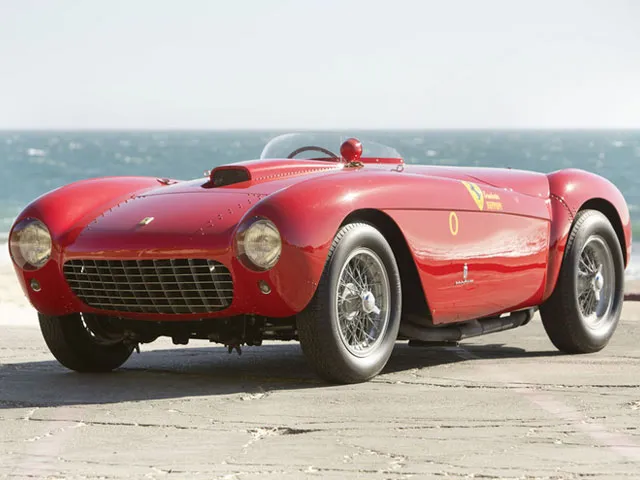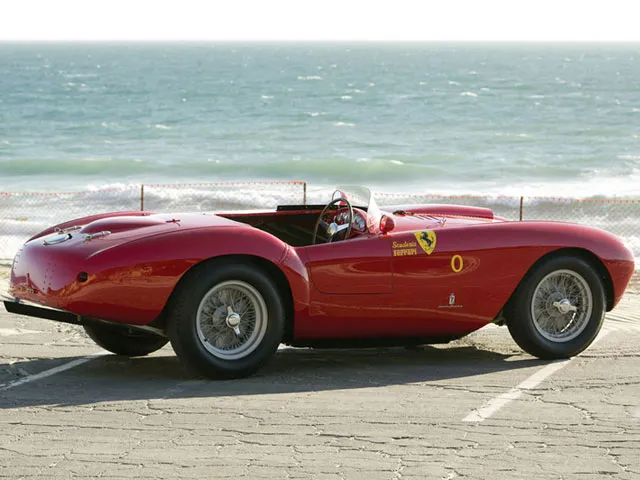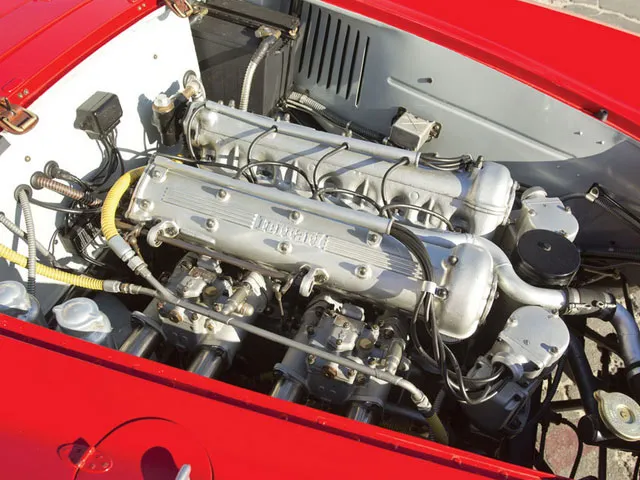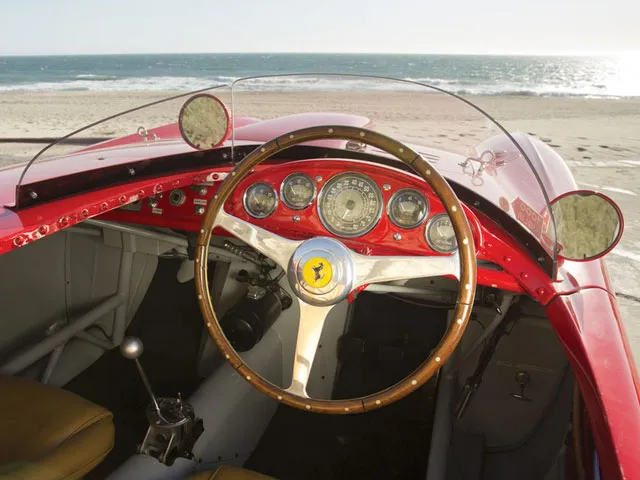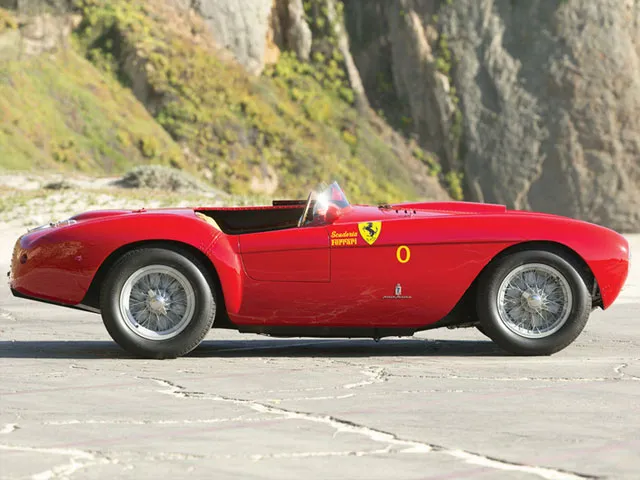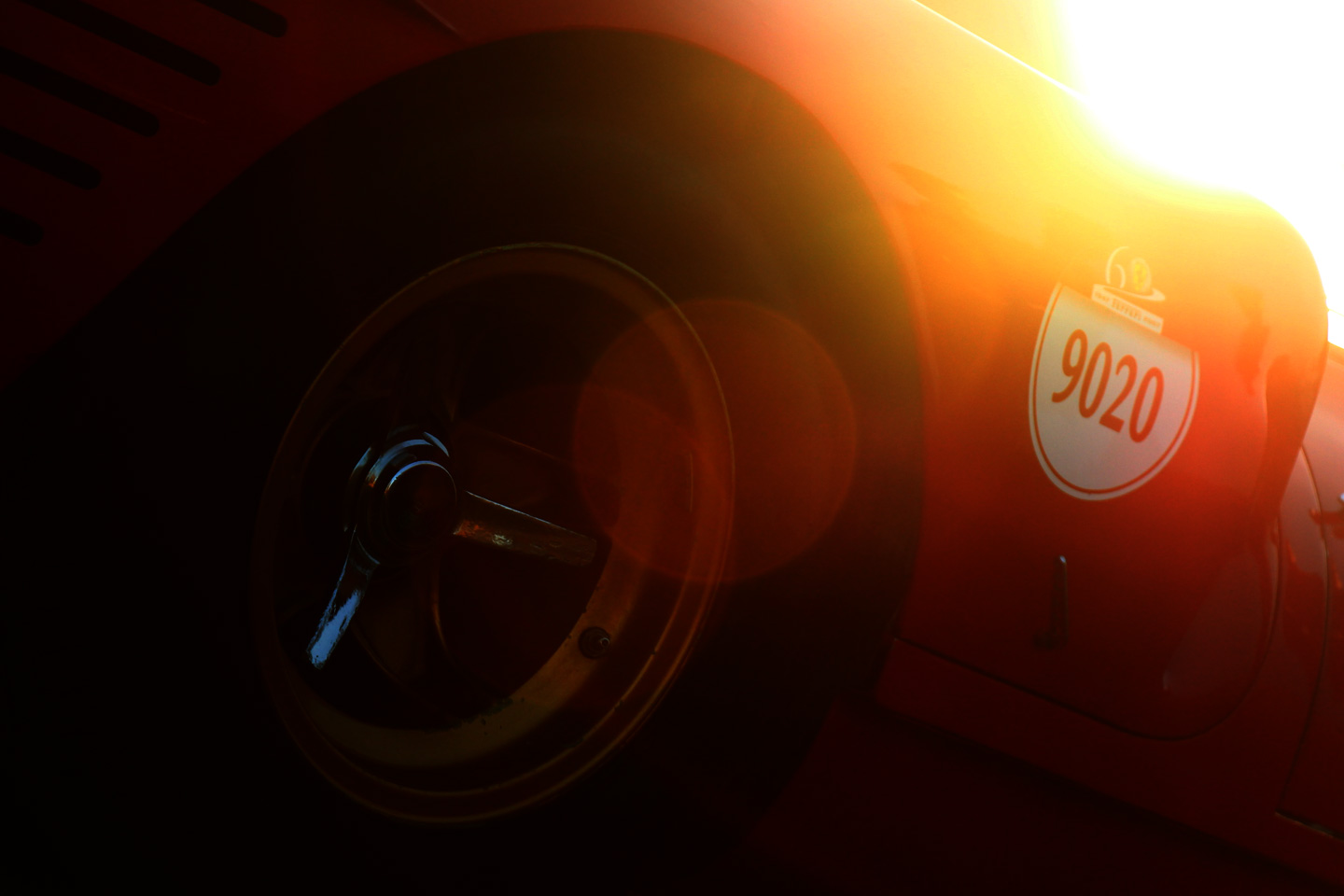Series I by Pinin Farina
Chassis no. 0418MD
Engine no. 0506MD
170 bhp, 1,984 cc dual overhead-camshaft inline four-cylinder engine with two Weber 40 DCOA/3 carburetors, four-speed manual transaxle, independent front suspension with transverse leaf springs, de Dion rear axle with parallel trailing arms and semi-elliptic leaf springs, tubular steel frame, and four-wheel drum brakes. Wheelbase: 88.6 in.
Previous ownership - the Estate of William H. Tilley
One of four factory Works entrants in the 1954 Mille Miglia
Ferrari Classiche Red Book certification
Presented and awarded at numerous Concours d’Elegance, including Pebble Beach and the Cavallino Classic
History documented by Ferrari expert Marcel Massini
Though Ferrari is best known for its prodigious front-engine V-12 road cars, the manufacturer actually produced several models of four-cylinder sports/racers during the 1950s that are every bit as breathtaking as their more muscular siblings. During the 1950 Formula Two races, Enzo Ferrari noticed that four-cylinder race cars from manufacturers like HWM and Cooper were hot on the tails of his 12-cylinder cars on the handful of twisty circuits that generally lacked long straightaways.
The fact was that the four-cylinder engines developed peak torque at a much lower rpm band than the 12-cylinder cars, enabling them to maximize their potential in a far shorter distance. By contrast, the high-revving V-12 cars were only developing a fraction of their power when the next set of turns required braking. Aware of this inherent flaw in the V-12 on such winding courses, Ferrari assigned Aurelio Lampredi to develop a four-cylinder motor, which eventually debuted during the 1951 Bari Grand Prix as a 2.5-liter unit that could develop 200 horsepower.
Ferrari’s foresight turned out to be quite prudent, as Formula One racing was essentially cancelled during the 1952 and 1953 seasons because Alfa Romeo withdrew from competition, leaving Ferrari as the only remaining entrant of note. Therefore, Formula Two events became the basis of the Driver’s Championships during those two years, and the Lampredi engine was ideally poised to dominate. Scuderia driver Alberto Ascari had little trouble in securing consecutive championships in the four-cylinder F2 monoposto, bringing Ferrari the title in 1952 and 1953.
Once it became clear how effective Lampredi’s four-cylinder motor was, experimentation with sports/racing chassis was inevitable, and various combinations involving all three iterations of the new engine, which had been developed in 2-liter, 2.5-liter, and 3-liter forms, were eventually attempted. In early 1954, Ferrari finally offered the four-cylinder sports/racer to customers as a two-liter model, with each cylinder displacing almost 500 cubic centimeters. The car was dubbed the 500 Mondial, in recognition of Ascari’s back-to-back World Championships.
Starting with chassis 0404MD, 18 spiders and two berlinettas were built over a run of first-series cars, most of these bodied by Pinin Farina. A second series of 10 Scaglietti-bodied cars with slightly more powerful engines followed, resulting in a total of just 30 examples of the 500 Mondial before it gave way to the three-liter 750 Monza. Unlike the prototype four-cylinder sports car that placed 2nd at the 12 Hours of Casablanca in late 1953, which had a standard frontally located gearbox, the customer cars featured a rear-mounted transaxle that further optimized weight distribution and handling. In addition to its rarity and notability as the customer car commemorating the 1952–1953 Ferrari Championships, the Series One 500 Mondial Spider is also significant as one of the final Ferraris to feature the elegant barchetta-style coachwork that defined Maranello’s early sports cars.
Chassis 0418MD is just the sixth 500 Mondial built, with its certificate of origin completed on April 8, 1954, and according to noted marque expert Marcel Massini, this car was one of four Mondials entered by the factory at the XXI Mille Miglia on May 1. While records do not precisely reflect who drove which chassis, it is now believed that 0418MD was driven by either Sterzi and Rossi or Pineschi and Landini, suggesting that the car may have finished as high as 15th overall and 5th in class.
Not long after, this Mondial was made available for purchase, and it was acquired on July 14 by Mario and Bianca Piazza, of Trieste. At the III Messina 10-hour race on July 24, 0418MD placed 11th overall. Though officially entered at the XXII Mille Miglia on April 30, 1955, and the Grand Premio Supercortemaggiore race at Monza on May 29, the car did not start at either race.
In mid-1955, this enchanting Spider was imported to Caracas, Venezuela, and purchased by Gustavo Garcia, who quickly resold it to Ramon Lopez, a driver with the Equipo Madunina. During its time in competition with the Venezuelan scuderia, 0418MD was also driven by Guido Lollobrigida, the cousin of Italian actress Gina Lollobrigida. Piloted by Mr. Lopez, the Mondial placed 10th overall at the 1955 Grand Prix of Venezuela and 2nd overall at Maracay in August 1956. When entered in the Venezuelan Grand Prix in November 1956, the car featured a new livery of white paint with a dark tri-color stripe, and a year later, it finished 14th overall at the 1957 event.
After some attention by Abele Caviccioli’s shop in Caracas, 0418MD was painted military green for a sponsorship by the Venezuelan Ministry of Defense, and then, it returned to white for its entry in the La Trinidad contest of March 1958, where it took 1st in class and was driven by Mr. Lollobrigida. The Mondial was photographically depicted during this triumph in the official 1959 Ferrari Yearbook.
During the early 1960s, the car passed through two more South American owners before being imported to the United States in 1964. Raced in the Midwest by Fox Valley Sports Car Club of Wisconsin, 0418MD was purchased a year later by Ken Hutchison, of Tower Lake, Illinois.
By 1970, the Mondial had come into the care of E. Fox, of Florida, and was equipped with a Chevy V-8, suggesting that the original MD-designated motor may have blown out during competition. A proper 500 Mondial engine was sourced from 0506MD (then owned by Bruce Lavachek, of Arizona,) and installed. As a motor from the second-series 500 Mondial with larger carburetors, the new engine brought a dividend of an extra 10 horsepower, further maximizing the car’s brisk performance. Within a few years, the Mondial was acquired by noted racing car collector David Uihlein, of Milwaukee, Wisconsin, where it rejoined the company of 0414MD, one of the three other Series One Pinin Farina-bodied Spiders that had been entered at the 1954 Mille Miglia.
Advertised by Joe Marchetti’s International Autos Limited, in Chicago, through a 1984 edition of Cavallino magazine, the Mondial was purchased by well-known collector William Jacobs, of Joliet, Illinois, who campaigned it at the 1984 Mille Miglia and retained possession until 1987, when the car was sold to Paul Tavilla, of Ft. Lauderdale, Florida. Under Mr. Tavilla’s care, 0418MD underwent a complete cosmetic and mechanical restoration, after which it was entered in the Mille Miglia Storica from 1987 through 1989. More notably, perhaps, the car was presented at the inaugural Cavallino Classic Concours d’Elegance in Palm Beach in February 1992, earning First Place in the four-cylinder class.
On June 11, 1993, 0418MD’s exhibition acclaim continued with a Second in Class at the 29th Annual FCA National Concours at Palm Beach Gardens, Florida. This Spider was shown one more time by Mr. Tavilla, at the Cavallino Classic in February 1995, before being purchased that December by Dennis Machul, of Oak Brook, Illinois. Mr. Machul treated the Mondial to some additional attention, commissioning a full restoration by the renowned Skip McCabe, of Mundelein, Illinois. Mr. McCabe expertly refinished the body in Rosso paint and installed a brand-new, period-correct interior and a revised hood with the addition of a 375 MM-styled hood scoop. Though, it should be noted that the original hood is also included with the car.
Completed in early 1997, the stunning restoration debuted that August at the Meadow Brook Concours d’Elegance in Rochester, Michigan. Then, 0418MD resumed its vintage rallying pursuits, competing in the Ferrari North America Challenge Rally in Colorado in June 199 and the XI Colorado Grand in September, where it was photographed for issue number 134 of Prancing Horse magazine. Chassis 0418MD then earned a Platinum Award at the 2000 Cavallino Classic, and three months later, it was featured in issue number 116 of Cavallino magazine.
This sensational 500 Mondial placed 6th overall in the race for drum-brake cars at the Ferrari-Maserati Historic Challenge at Road America in August 2000, and again, it campaigned at the Colorado Grand in 2001. Mr. Machul exhibited this Spider at least twice more during his ownership, including at the 2005 Cavallino Classic. In March 2005, chassis 0418MD was purchased by Oscar Davis, of Elizabethtown, New Jersey, who presented the car at Cavallino in 2006 and participated in the Mille Miglia in 2007.
Acquired from Mr. Davis by Mr. Tilley in 2009, it is no overstatement to say that the extraordinary Pinin Farina Spider immediately became the crown jewel of his Ferrari collection, as it would with most such collections. Featured as the cover car of the November 2009 issue of Sports Car Market magazine, 0418MD continued to occasionally grace California’s concours over the next few years, winning the ICON Award for Most Sporting Classic at the Rodeo Drive Concours d’Elegance in June 2010 and appearing at the Pebble Beach Concours d’Elegance in August 2012.
Today, 0418MD’s restoration has held up beautifully, with very nice paint, an interior marked only by continued use on rallies and events, and extremely good panel gaps throughout.
By loosening the leather hood straps, the entire hood can be taken off for closer inspection of the engine. The engine bay is very tidy and everything appears correct. Fitted on the driver’s side are two side-draft Weber 40DCOA/3 carburetors that are numbered 106 and 102, respectively. The engine stamping appears on the passenger-side center section of the engine block and is stamped 0506MD, in the correct font. The numero interno for this engine also appears on the rear of the engine block, and it carries the stamping 30MD, which is correctly designated to this motor and is confirmed by Ferrari Classiche, as stated in the certification binder. The chassis number appears clear on the main left chassis tube towards the front of the car, and it is stamped 0418MD. Interestingly, the steering box number, which can be found clearly under the front of the nose on the underside of the steering box itself, is dated and numbered 2 4 54, unit number 52; in other words, the steering box is most likely the original one delivered on the car, as it is dated only six days prior to the final completion date on April 8, 1954. What is significant about this is that it indicates that the steering box is the original one to the car, and it also signifies that there was never any major front-end damage. Many of these cars that have suffered front-end damage have replaced their steering boxes with later date and unit stampings.
Tastefully fitted to 0418MD are modern cooling fans, a current electronic ignition, and full belly pans, which are all desirable and necessary upgrades for modern driving or rally events. These items can easily be removed should the cars next owner wish to show the car at concours events and bring it back to completely original configuration.
The dash is particularly attractive with five highly visible Veglia gauges. All the gauges work properly, and there is no cracking or damage to any of them. Chassis 0418MD rides on four correct Borrani wire wheels, which are fitted with period-looking Dunlop Racing tires. The wire wheels are painted grey, and they are all equipped with correct chrome center-locking Borrani knock-offs.
The car is currently equipped with two mirrors, and it comes with the passenger side cover, for a more streamlined, aerodynamic look; a larger, full two-person windscreen; the original hood, which lacks the center scoop; the spare tyre, which is located in the rear; the ever-important red Ferrari Classiche certification binder; and full FIA and FIVA paperwork.
This car remains an eligible candidate for numerous vintage events of note, where its torque-happy delivery at low rpm ensures delightful bouts of competitive rallying. Future ownership that is intent on display can also be assured that 0418MD will continue to draw consideration at national events, where its unique provenance as an early 1950s Ferrari sports/racer will always earn the admiration of knowledgeable enthusiasts. Impeccable in every respect, this superb Pinin Farina-bodied 500 Mondial is an exceptional example of Ferrari’s early four-cylinder sports cars that is undoubtedly worthy of the most accomplished collections.
